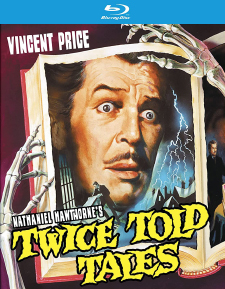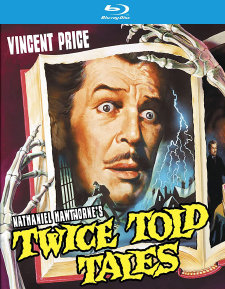Twice Told Tales (Blu-ray Review)

Director
Sydney SalkowRelease Date(s)
1963 (September 6, 2021)Studio(s)
United Artists/MGM (Kino Lorber Studio Classics)- Film/Program Grade: C+
- Video Grade: A
- Audio Grade: A
- Extras Grade: B
Review
Vincent Price joined Roger Corman in the 1960s to star in a series of movies adapted from Edgar Allan Poe tales. In 1963, Price headed over to United Artists to appear in Twice Told Tales, a trilogy based on three Gothic works by Nathaniel Hawthorne—the short stories Dr. Heidegger’s Experiment and Rappaccini’s Daughter, and the novel The House of Seven Gables. Each episode begins with a pair of skeleton hands opening a book with the title on the cover.
Dr. Heidegger’s Experiment features two elderly, longtime friends, Dr. Carl Heidegger (Sebastian Cabot, The Time Machine) and Alex Melbourne (Vincent Price), discussing their lives on the occasion of Heidegger’s birthday. Carl’s fiancee, Sylvia (Mari Blanchard, McClintock!) died on the eve of their wedding 38 years ago. He’s still in love with her memory, and has never married. When a storm blows open the entrance to Sylvia’s crypt, the men are amazed to discover that her body is perfectly preserved. Heidegger sees that water has been dripping onto her coffin and seeping inside. Surmising that the water has prevented her from decaying, he collects some and drinks it. In an instant, he regains his youth. Alex then drinks the magical liquid and becomes young again. Heidegger believes the water can bring Sylvia back to life. His experiment succeeds, only for him to learn an unpleasant truth about the woman to whose memory he’s devoted his life.
Rappaccini’s Daughter is the beautiful Beatrice (Joyce Taylor, Atlantis, the Lost Continent), daughter of the noted botanist Giacomo Rappaccini (Price). To prevent Beatrice from becoming like his unfaithful wife, now deceased, he has cultivated a deadly plant and acclimated her to frequent injections of its poison so that anyone who touches her will instantly die. Young university student Giovanni (Brett Halsey, Return of the Fly) sees his lovely new neighbor in her garden from his flat next door and is instantly smitten. Beatrice refuses to admit him in order to protect him, though he doesn’t understand and tries to persuade her to so that he can get closer to her. Observing Giovanni’s repeated pleas that Beatrice let him in and her increasing attraction to him, Rappaccini invites Giovanni to see if things can be worked out, and events take a strange, dark turn.
The House of the Seven Gables finds Gerald Pyncheon (Price) returning to his family home with his new bride, Alice (Beverly Garland, The Mad Room), despite warnings of the curse on the New England house. He wants to find the treasure rumored to be hidden in a vault somewhere in the house. Gerald’s greatgrandfather accused an innocent man of witchcraft and made sure he was convicted in order to steal his property and build the house on it. From then on, all Pyncheon men have been cursed. Alice comes to realize from a series of bizarre events that the house exudes evil.
Though all three tales have an element of the macabre, they’re tame in terms of horror, talky, and padded. At two hours, the film is too long. Each of the stories should have run no longer than 30 minutes for greatest effectiveness. As is, they overstay their welcome. Sidney Salkow (Chicago Confidential), primarily a TV director, paces the film sluggishly and does little to make it visually interesting. The film suffers from blandness.
Price shores up this shaky trilogy with his usual distinctive performance. He’s a reliable actor and always enjoyable to watch. But here he’s given no chance to inject a good quip occasionally or even to raise an eyebrow. He plays all three roles straight and comes off stodgy and dull. His character is secondary in the first two episodes—a waste when one of the screen’s foremost masters of the macabre is relegated to second banana.
Of the supporting cast, Sebastian Cabot turns in a respectable performance, but Halsey, Garland, and Taylor go through the motions and are unconvincing. Garland is embarrassing with her amateurish portrayal of a woman increasingly terrified of manifestations in the house. Her weak, theatrical screams fail to convey genuine terror.
Screenwriter Robert E. Kent has truncated The House of the Seven Gables so much that only a few bare bones of Hawthorne’s novel remain, fleshed out with as much as possible of Poe’s The Fall of the House of Usher.
Horror aficionados will likely be disappointed by the quantity of exposition, lack of action, and paucity of genuine scares. Dr. Heidegger and Seven Gables take place mostly indoors, but Rappaccini’s Daughter was an opportunity to shoot outdoors in a garden filled with richly colored flowers. Instead, the garden is a sound stage set and looks it, with washed-out flowers, fake grass, and studio lighting that in no way replicates natural sunlight. A wind machine could have at least suggested a gentle breeze. A limited budget is understandable, but when corners are cut to such a degree, the story suffers.
Twice Told Tales was shot by director of photography Ellis W. Carter on 35 mm film with spherical lenses, finished photochemically, and presented in the aspect ratio of 1.66:1. Kino Lorber brings the film to Blu-ray for a second time using the same master as their 2015 release. The picture quality is sharp and distinct. Color isn’t used especially well. There are no imperfections such as scratches, cue marks, embedded dirt particles, or emulsion clouding. Artificial blood looks fake (it’s too bright) and the garden in the Rappaccini’s Daughter is clearly the result of the prop department and resembles a stage set. In Dr. Heidegger, the transformations of Price and Cabot are done through multiple dissolves and look pretty good. This technique is also used to show a dead rose coming back to life. The final appearance of Sylvia is an effective shock moment, one of few in the film. The title residence’s exterior in The House of Seven Gables is clearly a miniature. The climactic destruction of the house is created by a miniature combined with a set built on rockers, with debris falling and dust rising all around The film’s complete dependence on interiors makes it feel claustrophobic. Director Sidney Salkow never “opens up” the narrative.
The soundtrack is English 2.0 Mono DTS-HD Master Audio. English subtitles are an available option (which were not included on the 2015 Blu-ray). Dialogue is clear and precise throughout. Richard La Salle’s score is often more dramatic than the story, and is used intelligently to shore up peak moments. The sound of a rain storm in the first story is important and adds atmosphere. The final story ends with the rumblings and crashing sounds of the disintegrating house. Vincent Price opens and closes each story with a bit of off-screen narration from the Hawthorne works.
Kino Lorber’s Blu-ray also features a slipcover. Bonus materials include the following:
- Audio Commentary by Richard Harland Smith and Perry Martin
- Trailers from Hell with Mick Garris (3:05)
- Trailer (2:43)
- Tales of Terror Trailer (2:22)
- Master of the World Trailer (2:31)
- The Raven Trailer (2:29)
- The Comedy of Terrors Trailer (2:33)
- The Last Man on Earth Trailer (1:51)
- The Tomb of Ligeia Trailer (2:31)
- The Oblong Box Trailer (1:56)
- Scream and Scream Again Trailer (2:21)
- The Abominable Dr. Phibes Trailer (2:35)
- Dr. Phibes Rises Again Trailer (2:09)
- Theater of Blood Trailer (2:31)
- House of the Long Shadows Trailer (2:28)
In their commentary, film historians Richard Harland Smith and Perry Martin describe differences between the original Nathaniel Hawthorne source material and the film. Hawthorne’s “aesthetic tended to inference, understatement and suggestion.” Twice Told Tales capitalized on the success of the Roger Corman/American International Edgar Allan Poe adaptations. Made by United Artists, Twice Told Tales lacks the polish of the Poe-based films. The original title of Dr. Heidegger’s Experiment was The Fountain of Youth. Rappaccini’s Daughter owes much of its plot to Shakespeare’s The Tempest and Romeo and Juliet. The commentators feel that Joyce Taylor was miscast as Beatrice, noting the role called for a more ethereal type, like Audrey Hepburn. An overview of director Sidney Salkow’s career is provided. He directed many episodes of TV shows including 77 Sunset Strip, Mike Hammer, Death Valley Days, and Hawaiian Eye. He later taught filmmaking. Films that deal with dysfunctional parent-child relationships are discussed, including The Innocents, Frankenstein, and Dracula’s Daughter. The House of Seven Gables has often been simplified, had the supernatural element reduced, or its interpretation made purely dramatic.
Twice Told Tales, with its mundane adaptations, is far from top-tier horror. Its attempts to convey Gothic tales with eerie, occult elements may be more cautionary than chilling horror. They’re overly talky and never create adequate suspense to sustain interest. Vincent Price does the best with the script, but is hampered by its dreary dialogue.
- Dennis Seuling

